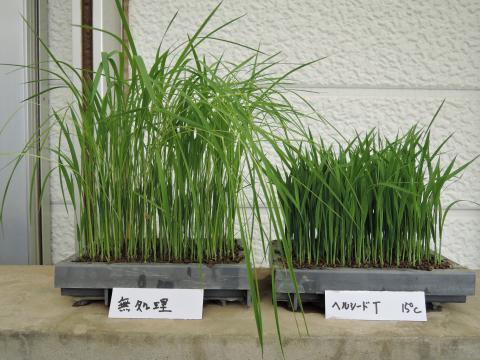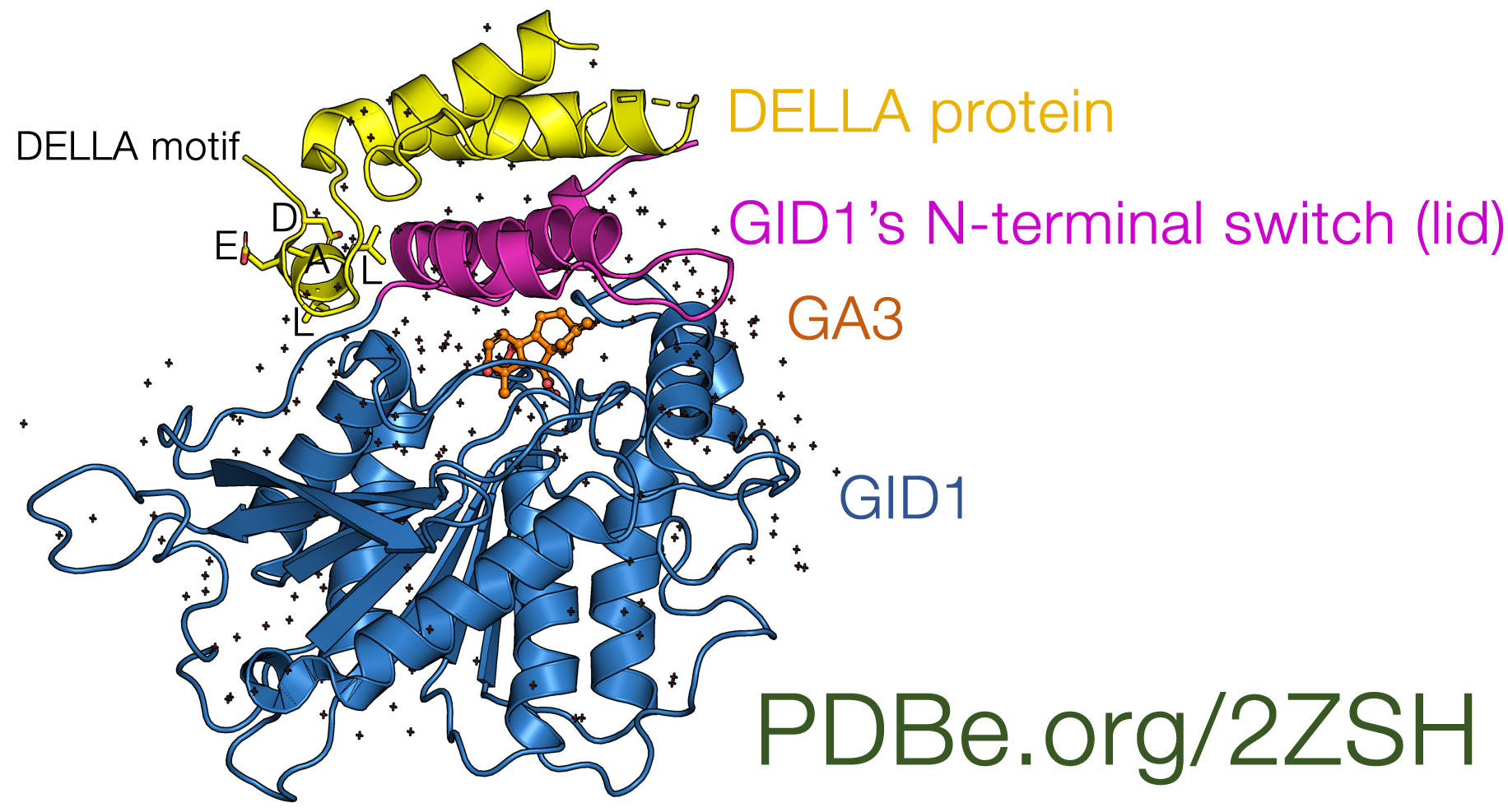
Foolish seedlings
In 1828 in Japan, certain rice plants were found to suffer from a disease called “bakanae” or “foolish seedling” disease. Such rice plants grew extremely fast, were thin, looked pale green, spindly, broke off easily, and could grow 50% longer than the healthy plants. The affected plants are not only unharvestable, but also sterile, producing no edible grains. At worst, they can grow so much that they become incapable of supporting their own weight, topple over, and die.
The disease started to be investigated in early 1900 by Shotaro Hori (1898) and Eiichi Kurosawa (1926), and they found the disease to be caused by a fungus, Gibberella fujikuroi. Kurosawa also found that the sterile filtrate of the fungus caused the appearance of disease symptoms in uninfected rice seedlings. The active substance, produced by the fungus, was purified by Teijiro Yabuta (1935), and later named gibberellin. Since that time, over 130 different gibberellin molecules have been identified from plants, fungi and bacteria, but only a few function as active hormones.

Gibberellins are plant hormones, and as such are responsible for a wide range of developmental processes throughout the life cycle of a plant. They stimulate growth in seeds, young leaves, and roots, are able to initiate seed germination, promote flowering, and increase fruit size. The plants will grow short or tall depending on the concentrations of gibberellins. The shoot-to-root ratio is a parameter that is closely studied in the context of agricultural productivity. Epidemics of Gibberella fujikuroi affect rice crops in Asia, Africa, and North America, and may result in a yield loss of 20% or more.
Gibberellin 3 (GA3), gibberellin receptor 1 (GID1), and DELLA proteins
Gibberellins are diterpenoid acids. Gibberellin 3 (GA3) is one of the bioactive gibberellins. It is hydroxylated at C3, and contains a lactone ring between C4 and C10 as well as a carboxyl group at C6.

Gibberellins regulate gene expression by binding to the gibberellin receptor 1 (GID1), a soluble protein localized both in the cytoplasm and the nucleus.
GA3 binds to a deep pocket on GID1, causing conformational changes in the structure of GID1: a “lid” moves to cover the GA3 binding pocket, resulting in the exposure of a surface which enables the binding of GID1 to DELLA proteins.
DELLA proteins are nuclear transcriptional regulators which act as repressors of plant development. DELLAs inhibit seed germination, seed growth, and flowering, and gibberellins reverse these effects.
The GA3-GID1-DELLA complex promotes the rapid degradation of DELLAs through the proteasome pathway, which launches the gibberellins signalling cascade. When in the GA3-GID1-DELLA complex, it is thought that DELLA proteins undergo changes in structure that enable their binding to F-box proteins, which catalyse the addition of ubiquitin to their targets. The addition of ubiquitin to DELLA proteins promotes their degradation via the 26S-proteosome. The degradation of DELLA proteins then releases cells from their repressive effects.

The crystal structure 2ZSH presents a ternary complex of GID1, GA3, and the N-terminal domain of a DELLA protein.
GID1 possesses a unique N-terminal extension of approx. 60 residues, which is highly conserved among a subset of gibberellin receptors. GA3 binds in a deep pocket, covered by the N-terminal switch region of GID1, which in turn interacts with the DELLA protein via its key DELLA motif (aspartate-glutamate-leucine-leucine-alanine or D-E-L-L-A in the single letter amino acid code).
Three helices are loosely packed to form a flat cover on the GA3-binding pocket and bury a broad surface of over 2400 Å2. The interface between GA3 and GID1 comprises both polar and nonpolar contacts, and contains many water molecules forming a hydrogen bonding network.
The DELLA domain also buries an accessible surface area of 2600 Å2 on GID1. The DELLA helices contact and stabilize the GID1 N-terminal extension helices that cover the pocket and trap GA3 by nonpolar interactions.

The structural investigation of gibberellins, gibberellin receptors and DELLA proteins has deepened our understanding of the degradation-signal-dependent regulation of cellular functions in plants.
Applications of gibberellins in agriculture and horticulture
Gibberellins are widely used in agriculture, horticulture, and are also commercially available for home gardening. Gibberellins are most widely used in grape production. The application of gibberellins is a regular practice to induce seedlessness in many grape varieties. The culture of seedless grapes such as the ‘Thompson Seedless’ cultivar also involves gibberellins, which are sprayed onto the grapes to increase fruit size.
Low concentrations of gibberellins can be used to end seed dormancy and increase the speed of germination. Gibberellins can promote flowering: more attractive and larger flowers are produced with an increased speed, and are therefore more financially profitable.
Deborah Harrus
About the artwork
Kirsty Yu, who is fascinated by plants, found inspiration in gibberellins to produce this amazing artwork using etching, gum Arabic, and screen print.
View the artwork in the virtual 2021 PDB Art exhibition.
Structures mentioned in this article
Structural basis of gibberellin(GA3)-induced DELLA recognition by the gibberellin receptor PDB ID 2ZSH
Sources
A Century of Gibberellin Research
A Short History of Gibberellins
Applications of Gibberellins in Agriculture and Horticulture
Chiba Prefecture Agricultural Improvement and Dissemination Information Network
Emerging Concepts in Effector Biology of Plant-Associated Organisms
Hormone Metabolism and Signalling in Plants
Gibberellin: Regulator of Plant Height
Gibberellin-induced DELLA recognition by the gibberellin receptor GID1


